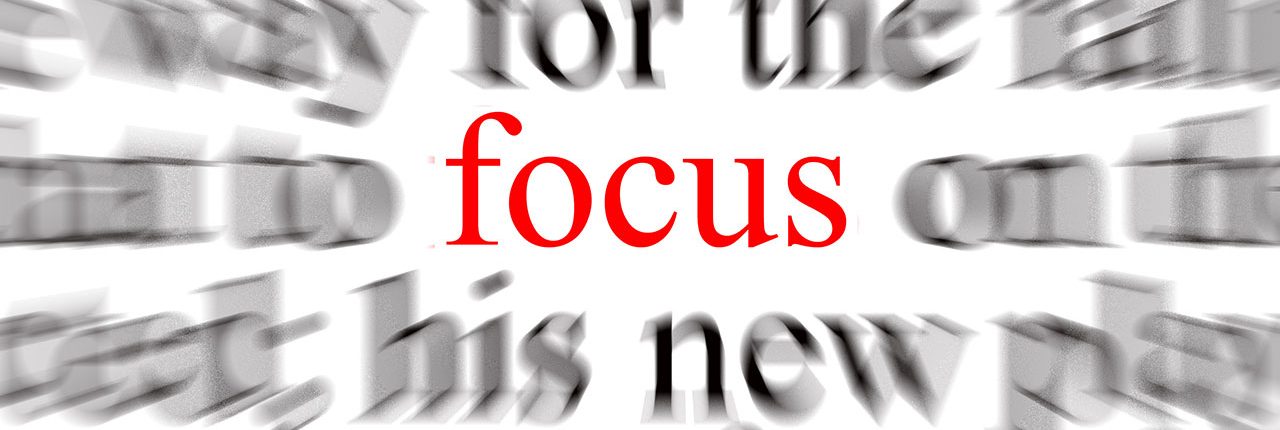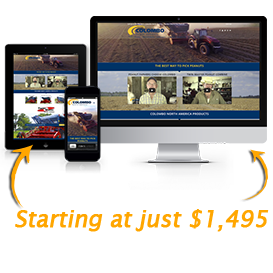The Power of FOCUS – How Multitasking Actually Sabotages Your Productivity & Creativity
As a small business entrepreneur since age 21, a single dad of three young boys, and a typically wide-open website designer and web developer I’ve learned firsthand that the skill of focusing is critical when it comes to being both productive and successful.
Often overlooked and more frequently downplayed by popular corporate culture, focus is the trump card in any successful entrepreneur’s playing hand. Although it’s more often than not devalued by the widely popular multitask productivity myth, focus is in fact the real and legitimate parent of accomplishment.
Why is focus such an important factor to getting work and other tasks accomplished? Obviously if you’re having issues with focus, then you’re not going to be very productive or creative. If focus isn’t present your likely not getting much productive work done anyways. Your creative juices begin to dry up and you become stuck in a productivity rut or even worse you’re regressing and falling further and further behind with important tasks at hand.
Multitasking vs. Focus (Being In The Zone) – A Popular Productivity Myth Debunked
Despite what the ever popular corporate culture wants us to believe, we as human beings are not wired up for multitasking. Multitasking indeed has its place but it’s not at the forefront of exemplary productivity and creativity. Performance wise we are at our peak when we’re focused. When we’re really focused and we’re leveraging our skills, creativity, and talents in a process that is challenging it becomes fertile ground for operating in a peak performance state known as “flow” or “being in the zone”.
We all can relate to the feeling of having your skill set completely match the challenge at hand to the point that you lose yourself in what you are doing. It’s akin to a relaxed state of complete concentration and absorption where you become ‘one’ with the task at hand – your sense of time is diminished or even nonexistent, any sense of nervousness or anxiety completely diminishes and trivial thoughts not related to the task at hand evaporate on the spot.
Moving From Scatter Brained To Laser Focused FLOW
So… how do you actually get and even more importantly stay focused? What are some practical ways to get this abstract notion of “flow” or “being in the zone” to show up in your life? Here are a few simple pointers that you can begin implementing immediately. The key to nurturing focus and becoming more productive has everything to do with eliminating or at least minimizing distractions. Ask yourself what are your distractions? What keeps you from being focused?

Make A Distractions List
Take just a few minutes and with pen and paper jot down five of your major distractions. What are five things that are keeping you distracted in whatever area of life you want to achieve more focus in? What’s distracting you at work? Is it a troublesome client who makes it a habit of consistently dropping by your office unexpectedly and without appointment? Is it a friend or significant other who calls or texts and disturbs you every ten minutes? Is it a barrage of emails? Is it your Facebook notifications that keep pinging you on the hour? You need to get very clear and honest with yourself about what’s really distracting you.
I’ll venture to bet that once you get your distractions identified on paper, that what you’ll find is that one of the biggest culprits to your ability to focus is multitasking. You’re attempting to do multiple things at once.
The Laser Focus Analogy
All of your distractions are the antithesis of focus. When you’re attempting to do several things at once, you are by definition not focused. You are dividing your focus and attention. When you divide or diffuse your attention, it’s the exact opposite of the phenomenon that makes a laser work so well.
A laser differs from other sources of light in that it emits light coherently. This phenomenon known as “Spatial Coherence” allows a laser to be focused to a tight spot, enabling applications such as laser cutting and lithography. Spatial coherence also allows a laser beam to stay narrow over great distances (collimation), enabling applications such as laser pointers.
Many principles that underlie phenomenon are applicable when applied to different scenarios and contexts. Likewise this same principle applies when it comes to our attention. When it’s scattered and not focused it becomes much less effective. If you want success in your career, your business, a relationship or essentially in any endeavor, you should put your focused attention on it. Your undivided attention has to be focused on whatever it is you’re doing if you expect anything worthwhile to come from your efforts. You can’t do that effectively if you’re always trying to multitask. Make no mistake about it multitasking and the “being busy feeling” that it often engenders in us is just that… a feeling. It’s a productivity illusion if there ever was one.
Feeling busy is by no means a good indicator of actual productivity. For further proof of this fallacy in assumption just look back at your greatest achievements and creative moments. I’ll bet when you analyse them honestly you’ll discover it’s the exact opposite. You didn’t feel busy at all. More than likely you were in flow. You were relaxed. You were in the zone and even the concept of “being busy” would have been foreign to your thought stream. You may have appeared busy to an onlooker but on the inside you were actually effortlessly dancing on the cusps of grace.
Make no mistake about it multitasking and the “being busy feeling” that it often engenders in us is just that… a feeling. It’s a productivity illusion if there ever was one.

Introducing Working In Block Time – The ZEN of Great Productivity
To work in Block Time you’ve got to basically set off sixty to ninety minute blocks throughout your day. These are blocks where you sit down and work on a single task and you do nothing else. You don’t let yourself get distracted by anything. You don’t let yourself get up and do other things. You focus on that one task at hand. You stop attempting to do multiple tasks at the same time. It’s a very simple yet powerful concept. Regular breaks are conducive to greater productivity and concentration. When implementing working in Block Time, schedule regular breaks in between activities. For example, focus intensely for 2 hours on a specific task, take a 10- or 15-minute break and work for another 2-hour block of time.
Don’t just take my word for it. Experiment with using Block Time yourself and watch both your productivity and creativity skyrocket. You’ll want to limit activities that interfere with your Block Time goals. Eliminate unproductive, time-consuming activities. During the block of time allotted to working, avoid unnecessary web and social media browsing, television watching, or texting. Devote your undivided attention to the high priority task at hand. You’ll also want to avoid checking email or answering the phone (unless it’s the specific task assigned for your Block Time).
Focus your full attention only on the task that you blocked off the time to work on. Your calls can go to voicemail. The emails can wait. The 5th Selfie your friend posted this week on Facebook can wait. You can let others know that you will be unavailable during this time. If you’re working at home, explain your strategy to your family so they won’t likely interrupt you. If you’re in an office setting, limit interruptions from co-workers or supervisors as best you can.
When you begin to work in this way and you’re super focused what you’re going to discover is that you get somewhat exhausted after each time block. You’ve actually put a tremendous amount of mental energy into the task you were working on. It’s imperative to give yourself a little bit of a break after each block. Ten to fifteen minutes minimum should be sufficient for most. That’s where you can go get a snack, grab a coffee, chat with your friends, take a walk outside, or even log onto Facebook and begrudgingly LIKE that 5th Selfie your friend just posted.
Fifteen minutes or so later, you’ll return and start on your next Block Time task. Be careful not to make the blocks too long either. If they are too long you’re going to get exhausted and this will actually end up being counterproductive. Sixty to ninety minute Block Times will be ideal for most. Basically you’ll have your day broken into these Block Times so that you’re focusing on one single task at a time.
Drop The Multitasking Mindset
As you develop a discipline for working in Block Time what you’ll find is that you’re really preventing yourself from unconsciously multitasking. You’ll be getting tasks completed much more efficiently and your creativity will be enthused with a new energy. People usually think their work and productivity are tied to the amount of time they put in. That assumption is not entirely true.
In reality productivity is more related to focus and the quality of the energy you’re putting into the task at hand. Who among us can’t identify with a task that should take 30 minutes actually taking hours to complete? Usually this happens when we’re doing many different things (multitasking) simultaneously while trying to complete a single important task.
Numerous scientific studies have shown that it can take upwards of 10 to 15 minutes to get your attention back on track after being distracted. This becomes even more of an issue if you’re doing creative or highly technical types of work. Those 10 to 15 minutes it will take you to get back into flow is time that is irretrievably lost.

Lately, I’ve been working on implementing the use of Block Time in managing my own web development company and the results of doing so are nothing less than amazing. At first it definitely felt counter-intuitive for me. Like so many among us I had unconsciously subscribed to the popular corporate culture which touts multitasking as a great asset. If you were good at multitasking it meant that you were not only flexible but valuable as an employee. In all honesty what they should have actually told us was that they were happy that we were willing to do more for less and that it was both convenient and profitable to have someone willing to routinely take on tasks outside of the job description.
I typically have as many as 7-10 different active web projects going on at any one given time. The natural inclination is to bounce back and forth on the different projects all throughout the course of a work day. I actually worked like this for years not knowing there was a better way. What I’ve discovered is that by assigning Block Time for each project during the course of my work day I tend to not only be more productive but the creativity that’s essential in my field is never lacking.
Give the Block Time practice a shot. I think you’ll find that you’re going to be not only more focused but in “the zone” a lot more often. Your productivity will improve tremendously and perhaps even more importantly you’ll feel a lot happier and less stressed.
Mark D. Hulett is the Senior eCommerce Website Developer & Designer at Georgia Web Development. His experience and working knowledge of eCommerce, website development and website design spans more than a decade.Mark responds personally to all inquiries and is more than happy to setup a quick phone call to discuss your project and answer questions.






